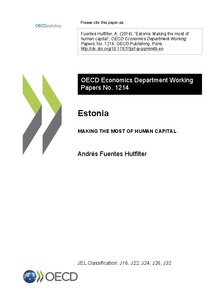Estonia: making the most of human capital
"Labour input in Estonia remains lower than before the crisis. Skill mismatches between workers and jobs contribute to structural unemployment and emigration, notably among young, employed workers, has reduced labour supply. Although the government has lowered labour taxes and further reduction...
| Main Author: | |
|---|---|
| Institution: | ETUI-European Trade Union Institute |
| Format: | TEXT |
| Language: | English |
| Published: |
Paris
2015
OECD |
| Subjects: | |
| Online Access: | https://www.labourline.org/KENTIKA-19112756124919309389-estonia-making-the-most-of-hum.htm |
| Summary: | "Labour input in Estonia remains lower than before the crisis. Skill mismatches between workers and jobs contribute to structural unemployment and emigration, notably among young, employed workers, has reduced labour supply. Although the government has lowered labour taxes and further reductions are planned, government revenues still rely heavily on taxing employment. Shifting some of the tax burden on labour to real estate would make the tax system more employment friendly. High costs reduce the returns workers earn on the assets in the compulsory private pension system, effectively raising the tax burden on labour. There is scope to reduce costs. In the public pension system, phasing out early retirement schemes for workers in specific sectors or professions would make room for lower social security contributions. They pay gap between men and women is substantial and further steps could be envisaged to reduce it. Reforms to improve the skills of Estonian workers have a high pay-off in view of increased demand for skilled workers. The recent initiatives of the government to foster life-long learning and improve financial support for students from low-income families in tertiary education are welcome. There is scope to promote apprenticeships, for example by fostering cooperation between local firms and local schools. This would help reduce skill mismatch. More financial support is needed for students, especially to ensure youth have access to upper secondary vocational education. This Working Paper relates to the 2015 OECD Economic Survey www.oecd.org/eco/surveys/economic-survey-estonia.htm" |
|---|---|
| Physical Description: | 29 p. Digital |

